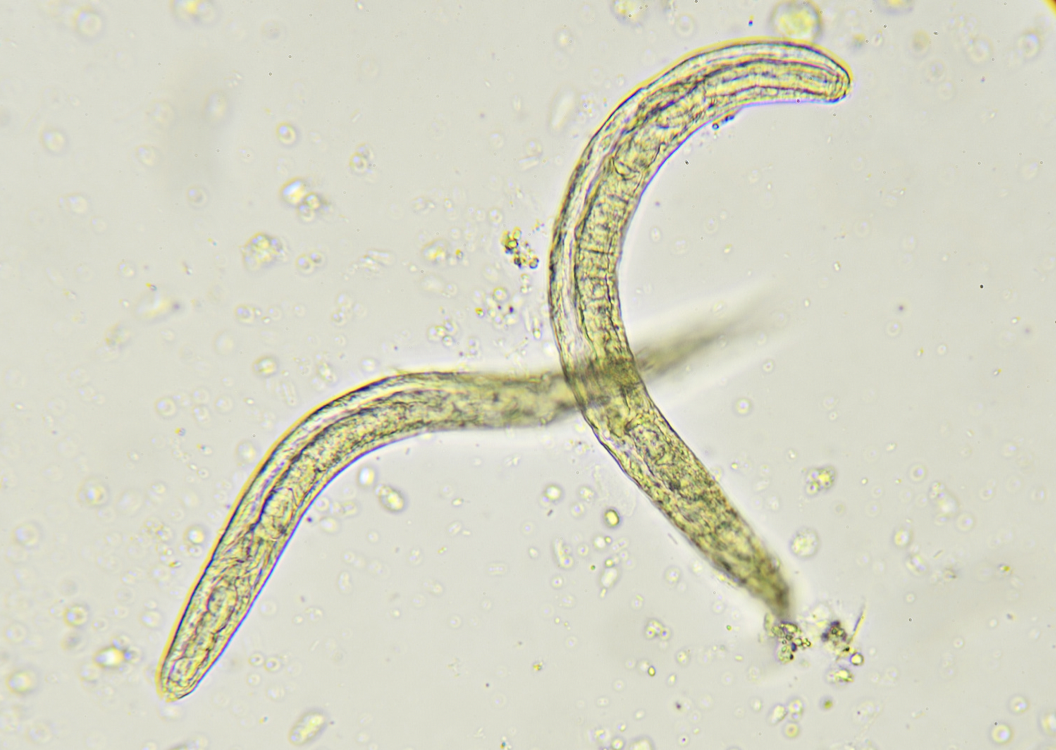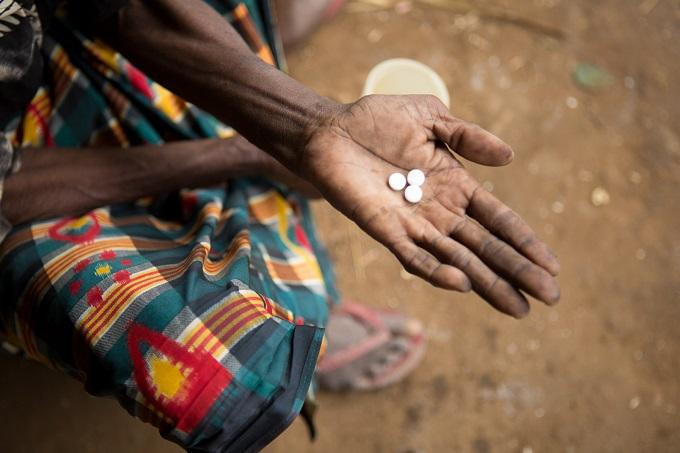Definisi
Strongiloidiasis adalah infeksi yang disebabkan oleh cacing gelang Strongyloides stercoralis. Cacing ini banyak hidup di daerah tropis dan subtropis dengan iklim yang lebih hangat. Diestimasikan sekitar 30–100 juta orang terinfeksi Strngoiloidiasis. Angka kejadian di Indonesia adalah sekitar 10%. Umumnya strongiloidiasis tidak menyebabkan gejala yang khas dan dapat dicegah dengan menjaga kebersihan diri.
Penyebab
Strongyloides stercoralis adalah spesies utama dari genus Strongyloides yang menyerang manusia. Terdapat sekitar 40 spesies lain yang dapat menginfeksi burung, reptil, amfibi, hewan ternak dan primata. Larva dari cacing ini berukuran kecil, hanya sekitar 600 µm sehingga sulit untuk dilihat dengan mata telanjang.
Strongyloides stercoralis diklasifikasikan dalam soil-transmitted helmints atau cacing yang menyebar melalui tanah. Hal ini berarti cacing ini dapat menginfeksi manusia dari kontak dengan tanah yang terkontaminasi dengan larva. Ketika larva berkontak dengan kulit, larva dapat berpenetrasi dan bermigrasi ke seluruh tubuh, kemudian mencapai usus halus. Di usus halus, larva akan tumbuh menjadi cacing dewasa (ukuran 2–3 mm) dan melukai mukosa dari usus halus. Cacing betina akan menyimpan telurnya pada mukosa usus. Dalam satu hari, cacing betina dapat bertelur hingga 40 buah.
Tidak seperti cacing lainnya yang telurnya tidak akan menetas di luar tubuh manusia, telur dari Strongyloides stercoralis dapat menetas di dalam tubuh. Sebagian besar larva ini akan dikeluarkan melalui feses, namun sebagian besar lainnya menetap di usus halus dan melakukan reinfeksi (autoinfeksi) dengan cara menyerang dinding usus halus atau masuk melalui kulit di sekitar anus. Autoinfeksi menyebabkan seseorang mengalami infeksi terus menerus sepanjang hidupnya.
Selain kontak langsung dengan tanah yang terinfeksi, terdapat beberapa cara lain cacing ini menginfeksi manusia, yaitu:
- Transplantasi organ
- Tinggal bersama orang lain dengan disabilitas kognitif dan membutuhkan bantuan dalam beraktivitas sehari-hari
- Rumah singgah
- Pusat daycare
Faktor Risiko
Faktor risiko yang meningkatkan kejadian strongiloidiasis adalah:
- Berjalan tanpa alas kaki
- Berkontak dengan kotoran manusia
- Pekerjaan yang berhubungan dengan tanah, seperti pertanian dan pertambangan
- Tinggal di daerah tropis
- Tinggal di daerah rural dengan kualitas sanitasi rendah atau fasilitas sanitasi yang tidak adekuat
- Menggunakan kotoran manusia sebagai pupuk
Gejala
Sekitar 50% dari penderita strongiloidiasis tidak mengalami gejala. Jika gejala terjadi, gejala tersebut antara lain:
- Nyeri pada perut bagian atas
- Diare, atau diare yang bergantian dengan konstipasi (sembelit)
- Batuk
- Ruam pada kulit yang berpindah dan menjalar
- Gatal pada kulit
- Ruam di sekitar anus
- Muntah
- Penurunan berat badan
- Demam yang tidak terlalu tinggi
Ruam dapat terjadi segera setelah kontak dengan cacing S. stercoralis. Gejala pencernaan lainnya terjadi dua minggu setelah kontak. Larva cacing baru dapat dideteksi 3–4 minggu setelah kontak.
Gejala dari strongiloidiasis dapat menjadi lebih berat pada orang-orang yang:
- Mengonsumsi obat-obatan kortikosteroid untuk asma atau PPOK (Penyakit Paru Obstruktif Kronik), lupus, asam urat
- Terinfeksi virus HTLV-1
- Memiliki keganasan, seperti leukemia dan limfoma
- Resipien transplan (orang yang menerima transplantasi)
Infeksi yang berat (hiperinfeksi) dapat menyebabkan kerusakan lanjut pada dinding usus, sehingga bakteri pada usus dapat menginfeksi tubuh. Perdarahan, malabsorpsi (gangguan usus), dan peradangan pada perineum/selaput tipis pada perut (peritonitis) dapat terjadi. Larva juga dapat masuk ke dalam sistem saraf pusat dan menyebabkan meningitis. Kondisi ini memerlukan penanganan segera.
Diagnosis
Dokter akan menanyakan mengenai gejala yang Anda alami. Dokter juga dapat melakukan pemeriksaan fisik berupa melihat adanya creeping eruption pada telapak kaki, bokong, dan tangan serta adanya nyeri pada ulu hati. Namun, gejala dari infeksi strongiloidiasis tidak khas, sehingga dokter memerlukan pemeriksaan lanjutan untuk membantu menegakkan diagnosis. Pemeriksaan tersebut antara lain:
- Pemeriksaan mikroskopis. Sampel yang digunakan untuk melakukan pemeriksaan ini berasal dari feses atau dari aspirasi duodenum. Larva umumnya dapat ditemukan dari satu sampel, namun pemeriksaan berulang dapat meningkatkan sensitivitas pemeriksaan. Jarak antar pemeriksaan yang direkomendasikan adalah 3 hari.
- Pemeriksaan darah lengkap. Pada pemeriksaan darah lengkap, dapat ditemukan peningkatan level eosinofil (salah satu jenis sel darah putih). Namun, pemeriksaan ini tidak spesifik terhadap strongiloidiasis.
- Pemeriksaan antigen. Pemeriksaan antigen pada darah dapat dilakukan untuk mendeteksi S. stercoralis. Pemeriksaan ini dilakukan jika dokter Anda mencurigai infeksi parasit, namun tidak ditemukan larva pada feses maupun pada aspirasi duodenum.
Pada hiperinfeksi, larva dapat ditemukan pada feses, sputum, lendir saluran pernapasan, urin, cairan rongga pleura (paru), dan cairan serebrospinal (otak).
Tata Laksana
Pengobatan dari strongiloidiasis dilakukan dengan obat antiparasit, seperti ivermectin dan albendazol. Kedua obat ini dapat membunuh cacing pada usus halus. Kedua obat-obatan ini dikonsumsi dengan resep dokter. Jika Anda mengalami gejala yang menetap, pemeriksaan feses perlu dilakukan kembali 2–4 minggu setelah konsumsi obat untuk memastikan Anda sudah tidak terinfeksi. Jika larva masih terdeteksi, pengobatan ulang perlu dilakukan. Pemeriksaan lanjutan terhadap tingkat eosinofil dan serologi juga perlu dilakukan untuk memastikan infeksi telah berhasil diatasi.
Pada kondisi hiperinfeksi, pasien strongiloidiasis memerlukan pengobatan antiparasit dan antibiotik yang lebih lama.
Dokter perlu melakukan skrining pada individu yang:
- Akan memulai konsumsi obat-obatan kortikosteroid atau imunosupresan lainnya
- Mengalami infeksi HTLV-1
- Mengalami keganasan darah, seperti leukemia atau limfoma
- Mendapatkan atau akan melakukan transplantasi organ
- Mengalami eosinofilia persisten yang tidak dapat dijelaskan dengan kondisi lain
- Memiliki riwayat perjalanan ke daerah endemik
Komplikasi
Strongiloidiasis yang terjadi terus-menerus dapat menyebabkan komplikasi sebagai berikut:
- Malnutrisi. Malnutrisi terjadi ketika usus tidak dapat menyerap nutrien dari makanan yang Anda konsumsi. S. stercoralis dapat melukai mukosa usus sehingga mengganggu penyerapan nutrisi.
- Hiperinfeksi. Hiperinfeksi adalah kondisi tingginya jumlah larva pada bagian tubuh tertentu. Infeksi berat akibat S. stercoralis dapat terjadi terutama pada pengguna obat-obatan yang dapat menurunkan sistem imun atau mengalami penurunan sistem imun akibat virus.
- Infeksi diseminata, yaitu kelanjutan dari hiperinfeksi dimana larva dapat ditemukan hampir di seluruh tubuh.
Dengan penanganan yang tepat, strongiloidiasis memiliki luaran yang sangat baik dan cacing dapat dieliminasi secara sempurna. Pada beberapa kondisi, pengobatan perlu diulang.
Pencegahan
Cara utama untuk mencegah strongiloidiasis adalah dengan menggunakan alas kaki ketika berjalan di atas tanah dan menghindari kontak dengan kotoran manusia. Pengelolaan limbah yang baik adalah cara pencegahan yang paling efektif. Selain itu, strongiloidiasis juga dapat dicegah dengan:
- Menggunakan jamban keluarga
- Mencuci tangan sebelum dan sesudah melakukan aktivitas
- Menghindari kontak dengan tanah
- Tidak menggunakan kotoran manusia sebagai pupuk
- Menggunakan sarung tangan ketika mengelola limbah atau sampah
- Menjaga kebersihan lingkungan
Kapan harus ke dokter?
Jika Anda mengalami gejala di atas atau merasa mengalami strongiloidiasis, periksakan diri Anda ke fasilitas kesehatan untuk memastikan diagnosis dan melakukan pengobatan.
- dr Nadia Opmalina
Centers for disease control and prevention. (2021). Strongyloides. Available from: https://www.cdc.gov/parasites/strongyloides/health_professionals/index.html#tx
Pearson RD. (2020). Strongyloidiasis. MSD Manual. Available from: https://www.msdmanuals.com/professional/infectious-diseases/nematodes-roundworms/strongyloidiasis
Seladi-Schulman J. (2018). Strongyloidiasis. Healthline. Available from: https://www.healthline.com/health/strongyloidiasis
Farthing M, et al. (2018). Management of strongyloidiasis. World Gastroenterology Organisation Global Guidelines. Available from: https://www.worldgastroenterology.org/guidelines/management-of-strongyloidiasis/management-of-strongyloidiasis-english












